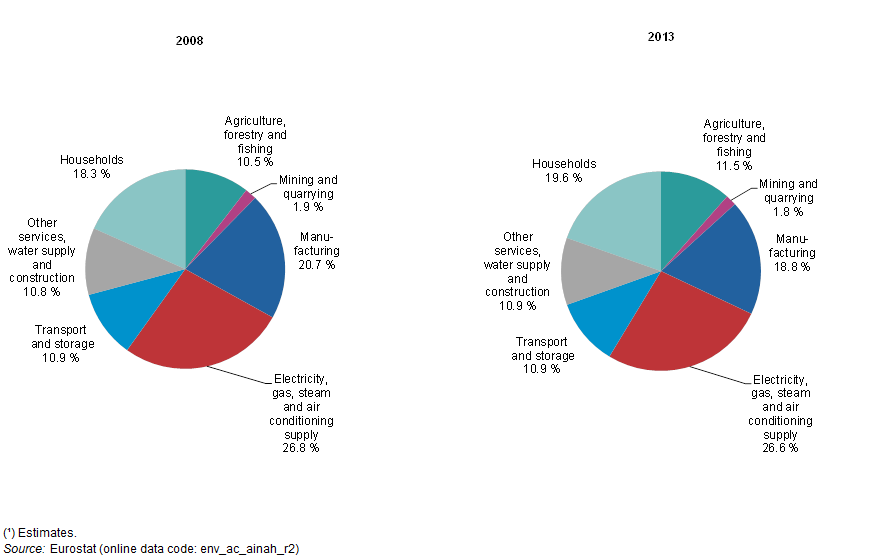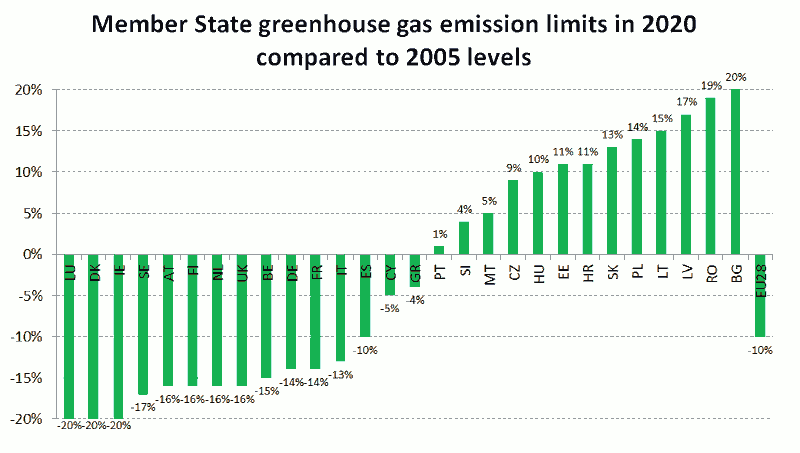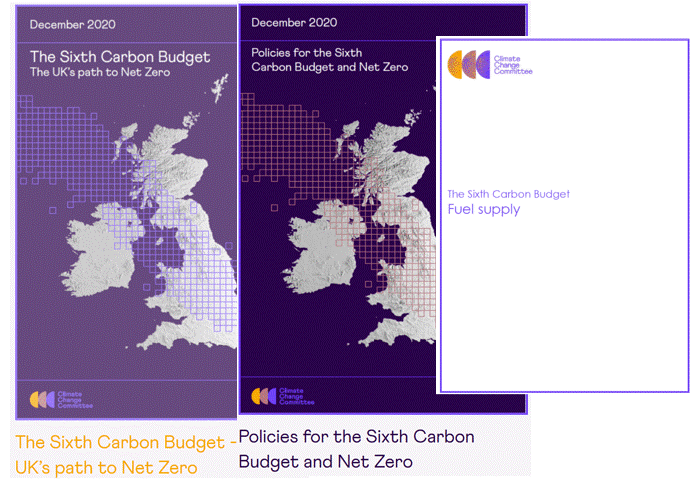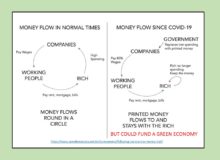The EU drives initiatives, targets and actions across all 28 member states to reduce Greenhouse Gases (including CO2), obliging each state to achieve agreed reductions. The EU monitors progress at an annual european semester and reports to the UN regularly The table below from a Eurostat report shows the sectors that need to be tackled to reduce GHGs.
Greenhouse Gas Sources across the EU from Eurostat: Greenhouse gas emissions by industries and households
from Eurostat: Greenhouse gas emissions by industries and households
Notes: The gases here are carbon dioxide (CO2), nitrous oxide (N2O) and methane (CH4)
Electricity/gas/steam/aircon emissions excludes combustion in individual houses or households – included in Households.
Transport excludes vehicles for non-transport businesses and private vehicles – included in Households.
Fluorinated gases (hydrofluorocarbons, perfluorocarbons and sulphur hexafluoride) are excluded (about 2 % of the EU’s greenhouse gas emissions)
Although it can be seen that the proportions have changed little between 2008 and 2013 the absolute totals have reduced by 11.8% over this period. In fact in July 2016 the 2014 figures reported by Climate Home showed that the EU had already achieved its targets for Greenhouse gas emissions and were 24.4% below the 1990 baseline. To minimise Global Warming – every Country in the EU (and across the world) needs to be ‘highly ambitious’ and do everything it can to reduce greenhouse gas emissions in every sector as much as possible and as quickly as possible.
EU Climate Change action
The EU is a Party to the UN Climate Change Convention and signed the Adoption of the Paris Agreement document on behalf of all the EU member countries in Dec 2015. (p23 para 18).
The formal Agreements, held by the Secretary-General of the United Nations in New York, are also to be signed by every Party, including the EU and each member state between 22nd April 2016 and 21st April 2017, as are their ratifications accompanied by Nationally Determined Contributions. For the UK it was signed on the first day by His Excellency Lord Bourne of Aberystwyth, Parliamentary Under-Secretary of State for Energy and Climate Change. The EU will ratify, following ratification in each State and the consent of the European Parliament.
Higher Ambition to minimise Global Warming
The EU was a major player in the ‘Coalition for Higher Ambition’ at the Dec 2015 Paris Conference, seeking higher level pledges from each country to try to restrict global warming to 1.5°C. In March 2016 Care Climate Change challenged the EU to drive the “development of a robust European policy framework, which will allow the EU to become a zero carbon economy”
At the same time the EU Commission committed to “present during the next 12 months the key remaining legislative proposals to implement the 2030 framework. This includes:
- proposals for an Effort-Sharing Decision for sectors not covered by the EU Emission Trading Scheme and on land use, land use change and forestry (LULUCF)
- legislation to set up a reliable and transparent climate and energy governance mechanism for the post-2020 period
- and the necessary policy proposals to adapt the EU’s regulatory framework in order to put energy efficiency first and to foster EU’s role as a world leader in the field of renewable energy.”
It is these actions that will need to be much more ambitious from every EU country to fulfill the Higher Ambition.
Prior to Higher Ambitions being in place
The EU actions in place were encompassed in the 2020 Package. The package set three key targets:
- 20% cut in greenhouse gas emissions (from 1990 levels)
- 20% of EU energy from renewables
- 20% improvement in energy efficiency
And these are either covered under the ETS or by national emission targets.
————————————————————————————-
The EU has now agreed the 2030 Framework for the period between 2020 and 2030. The framework set three key targets:
- a 40% cut in greenhouse gas emissions compared to 1990 levels
- at least a 27% share of renewable energy consumption
- at least 27% energy savings compared with the business-as-usual scenario
and these include a reformed ETS.
The effects of the 2030 Framework are evaluated in DG Climate Action scenarios.
- “Current policies are sufficient to reduce greenhouse gas emissions by 44% by 2050 compared to 1990, but fall short of the long term objective of -80%
- Even given current policies and trends, large scale investments are necessary in order to modernise the EU’s aging power sector
- The cost of our energy system relative to our income will rise in the short to medium term, but drop again in the longer term“
Carbon Emissions from Households
Note: The Household Sector also includes personal transport and electricity/gas/steam/aircon emissions from individual households – neither covered here.
“Buildings are responsible for 40% of energy consumption and 36% of CO2 emissions in the EU.“ (EU Energy page)
The Energy Performance of Buildings Directive 2010/31/EU requires all new buildings to be nearly zero-energy by the end of 2020. All new public buildings must be nearly zero-energy by 2018.
According to the summary at the EU Energy page the scope includes:
- “energy performance certificates are to be included in all advertisements for the sale or rental of buildings
- EU countries must establish inspection schemes for heating and air conditioning systems or put in place measures with equivalent effect
- all new buildings must be nearly zero energy buildings by 31 December 2020 (public buildings by 31 December 2018)
- EU countries must set minimum energy performance requirements for new buildings, for the major renovation of buildings and for the replacement or retrofit of building elements (heating and cooling systems, roofs, walls, etc.)
- EU countries have to draw up lists of national financial measures to improve the energy efficiency of buildings”
And the Energy Efficiency Directive 2012/27/EU includes:
- EU countries must draw-up long-term national building renovation strategies which can be included in their National Energy Efficiency Action Plans.
Tracking and reporting on meeting nearly zero-energy.
‘Nearly zero-energy’ for new buildings is reported for each country. Click here for progress reports and national plans.
VAT on energy saving materials for retrofits
The EU commission is consulting on changes to the VAT rules, whereby countries may be able to have more discretion as to which items can be zero rated. But under existing (non-ambitious) legislation, the EU ruled in June 2012 that VAT on solar (and all other Energy Saving Materials) in the UK should be at standard VAT (20% instead of 5%). And in Feb 2013 the European Commissioner took the UK to the European Court of Justice for a ruling. In Nov 2015 the intention of the UK Government was to increase the VAT on solar panels to comply at 20%, but Greenpeace reported in March 2016 that the Chancellor had announced that “installation of all energy saving materials including solar panels, wind turbines and water turbines will also continue to benefit from the current, reduced rates of VAT.
Carbon Emissions from Transport, Power and Industry
The EU has covered a wide range of Transport emissions with these policies:
- “aviation has been included in the EU Emissions Trading System (ETS);
- a strategy is in place to reduce emissions from cars and vans, including emissions targets for new vehicles;
- a strategy for reducing heavy duty vehicle fuel consumption and CO2 emissions;
- a target is in place to reduce the greenhouse gas intensity of fuels;
- rolling resistance limits and tyre labelling requirements have been introduced and tyre pressure monitors made mandatory on new vehicles;”
- legislation encouraging national authorities to deploy gas and electricity infrastructure; and,
- public authorities are required to take account of life time energy use and CO2 emissions when procuring vehicles.”
Carbon emissions from Forests and Agriculture
Forests and Agriculture, for industrialised nations, are accounted for and governed by the Kyoto Protocol (77 kB) adopted in 1997.
“Carbon dioxide (CO2) can be stored in large quantities in the various carbon pools in vegetation, soils and living organisms. As an illustration, it is estimated that the release of just 0.1% of the carbon currently stored in European soils would equal the annual emissions from as much as 100 million cars.”
The EU issued a consultation, concluding on the 18th June 2016, addressing greenhouse gas emissions from agriculture and LULUCF and this could be part of it’s Higher Ambitions.




